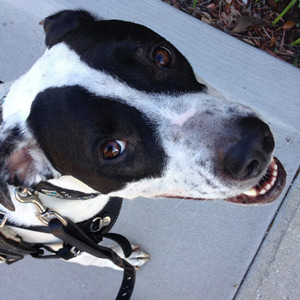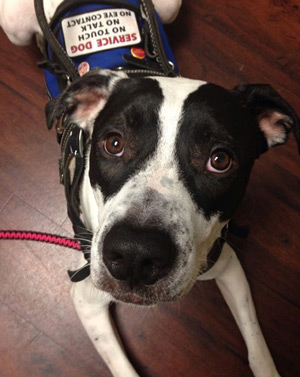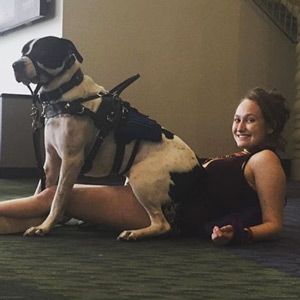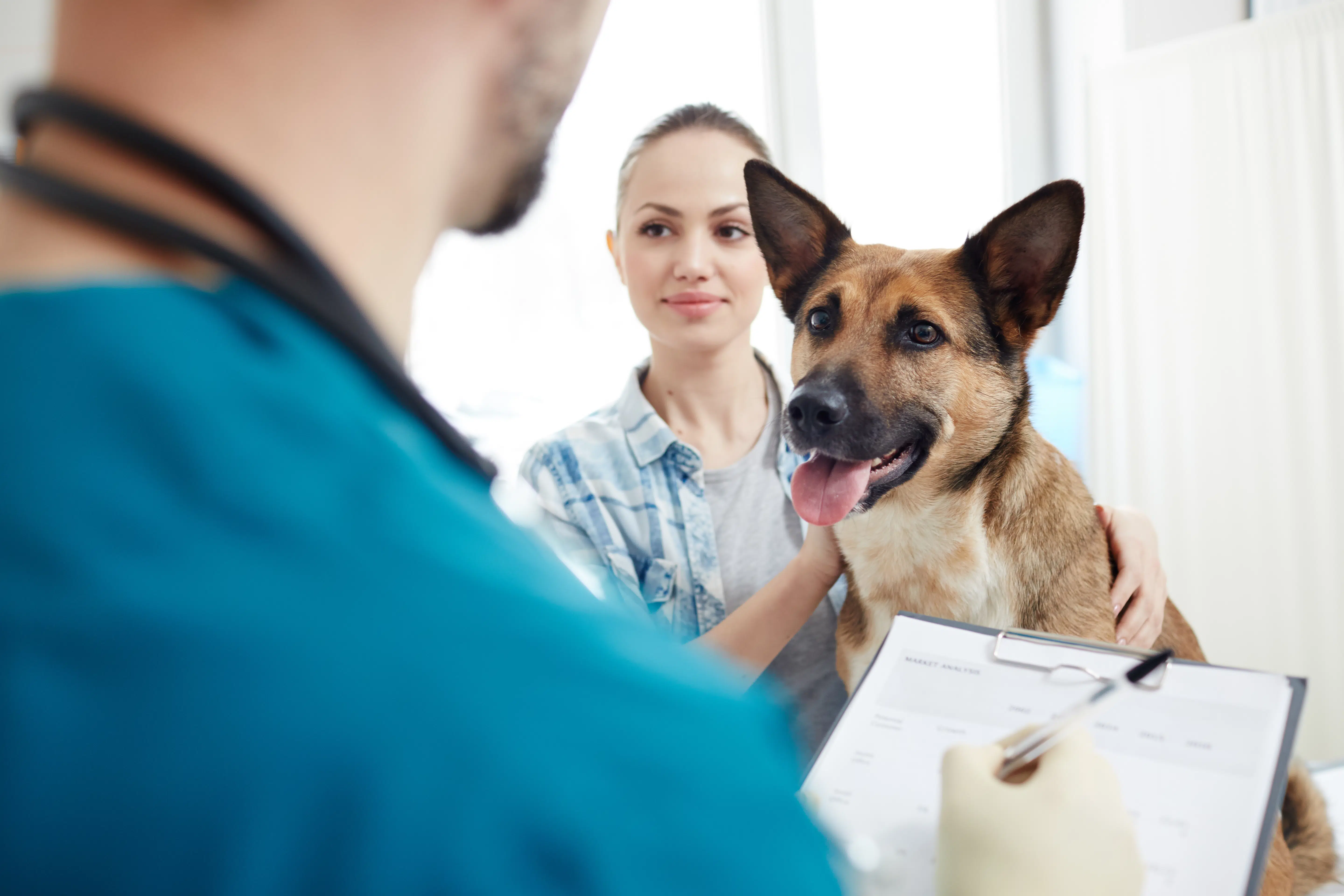Written by guest writer Lindsay
Most people are aware that service dogs must be permitted to accompany their disabled handlers into non-pet friendly businesses.
Unfortunately, many business owners are not aware that they too have rights concerning service dogs, and whether or not those service dogs are legally allowed to be in their business. There is much misinformation and fear surrounding the rights of service dog handlers, and thus, business owners. This article hopes to clear up some of these misconceptions, and to educate businesses on their rights, outlined in the Americans with Disabilities Act (ADA).
“…there has been an influx of pet owners dressing up their pets in vests and bringing them in public by claiming they are a service dog.”
What is a service dog?
The Americans with Disabilities Act defines a Service Animal as:
“A dog that has been house broken and individually trained to do work or perform tasks for an individual with a disability. The task(s) performed by the dog must be directly related to the person’s disability.”
Contrary to popular misconception, a service dog can be any breed, or combination of breeds, of any dog.
This could be your standard Labrador Retriever, or it could be a Terrier mix. Breeds are not discounted based on size, breed specific legislation, or public opinion. I personally work an American Bulldog/English Pointer mix named Cow. You cannot determine whether or not a dog is a service dog just by looking at their appearance.
You also cannot determine a service dog by the gear they are wearing.
The ADA permits disabled handlers to work their service dog in whatever gear they so choose; this includes working the dog completely free of any identifying gear. Some handlers choose to dress their dogs in a singular vest or cape with patches identifying the dog, and possibly asking the public not to pet or distract the dog. Some handlers require more intricate gear to accommodate their disability, such as a guide harness, or a mobility harness. Some handlers use a simple bandanna, a leash wrap stating “service dog,” or no gear at all.
What if I don’t think a dog is a service dog?
This is a fair question. Unfortunately, as any business owner will tell you, there has been an influx of pet owners dressing up their pets in vests and bringing them in public by claiming they are a service dog. Most businesses leave it at that, despite the dog’s misbehavior, out of fear or being sued or vilified by the media for discrimination.
As a business owner or employee, you have quite a few rights in this situation. First, per the ADA, you are allowed to ask two questions of any service dog handler:
“(1) is the dog a service animal required because of a disability, and (2) what work or task has the dog been trained to perform. Staff cannot ask about the person’s disability, require medical documentation, require a special identification card or training documentation for the dog, or ask that the dog demonstrate its ability to perform the work or task.”
What do they mean by “task”? A task is considered any trained behavior that mitigates the handler’s disability.
For example, this includes, but is not limited to, mobility and balance assistance, medical alert (cardiac alert, diabetic alert, seizure alert, blood pressure alert, etc.), guiding, alerting their Deaf handler to sounds, pulling wheelchairs, picking up dropped items, performing grounding tasks for psychiatric disorders, medication reminders, seizure response, blocking the individual from a crowd, removing the dissociated handler from the public space, alerting a person with PTSD that a stranger is coming up behind them, and more.
What is NOT meant by “task,” includes, but is not limited to, emotional support, comfort, protection, intimidation, or any other benefits unrelated to disability.
While service dogs may provide comfort by their mere presence, this is not considered a task under the ADA. If the animal is not trained to do anything else but provide comfort or emotional support, then they are not a service animal, even if their owner is disabled. More importantly, service dogs MAY NOT be used for protection or intimidation. Service dogs may intimidate people by their very presence, but this is not considered a task, and is highly frowned upon by the Department of Justice and other handlers. Service dogs should not have a high protection drive, and should not automatically protect their handler unless genuine harm is befalling them. After such an event, service dogs should be reevaluated by a qualified behaviorist to confirm that they are still fit to work around the public.
What about documentation or certification that the dog is indeed a service animal?
This will come as a surprise to most people, but there is no such thing as a certification or registration for service dogs. As a result, there is not legal identification or “paper” for service animals, and asking for one will only get you a long lecture by the handler, a sobbing handler in the middle of a panic attack, or a call to the Department of Justice or the police. In my personal experience, the people who carry and offer identification for their dogs are typically pet owners who have paid $75 to “register” their pet on a scam website in return for a vest, identification card, and paperwork stating that the dog is a service dog. This does not require any training or proof that the person is disabled and the dog is trained. It’s simply a scam that needs to be made illegal and prosecuted. Of course, this does not include paperwork from specific programs that some handlers carry as an extra precaution, or the fake identification that some legitimate handlers carry and use as a last resort if asked for it by an uninformed manager, as the handler’s disability prevents them from educating the often-belligerent employee.
How can I tell if a dog is a service dog?
Despite the lack of uniformity and identification amongst service dogs and their handlers, there are a few good ways to tell if a dog is really a service dog. The most important, and surest sign of a dog’s legitimacy and training is behavior. Behavior always shows, whether it be the behavior of the dog or the handler.

A service dog will have their basic obedience down pat.
They will not be incessantly sniffing merchandise, soliciting attention or barking at passersby, taking products off shelves, or leaving their handler to explore on their own. While some handlers do carry their small service dogs in their arms or in a sling, businesses do not have to allow dogs in shopping carts or baskets, and service dogs should never be on the business’ furniture unless their task demands it, such as performing deep pressure therapy on the lap of the handler. However, even during this task, the dog should not be using this opportunity to sniff food on the table of a restaurant or merchandise on higher shelves. The dog should be focused on their handler, not on the benefits of being higher than the floor.
” No dog is perfect, no matter their level of training or professionalism. This applies to service dogs as well. “
However, there are some tasks that appear to be the dog out of control.
For instance, my service dog, Cow, will perform a gradual alert if I am shut down and need to be led out of the public area. First, he will nudge my hand with his nose. If I don’t respond, he will graduate to more incessant alerts, such as pawing at my leg, with him finally ending up jumping his front half into my lap, pawing at my chest, howling quietly, before he hops down, and grabs his leash in his mouth and attempts to pull me. If I’m unresponsive to the first quieter, more subtle alerts, he will always end up performing the alert that looks as if he’s just misbehaving. Seizure alert dogs also occasionally use barking if their handler is unresponsive to their alerts.
It takes a trained eye to spot the difference between a service dog performing a task, and a pet dog throwing a fit, but the differences are there if you know what to look for. For instance, the service dog will always be focused on their handler, and will be trying to get the handler to do something, even if it’s not immediately obvious what that something is. For me, it is to allow Cow to lead me outside and to a safe, quiet place. For others, it could be to lay down to prepare for an impending seizure. Either way, the dog will have an obvious goal in mind, and they will not just be barking wildly and jumping on passerby. Seeing both in person often allows the layperson to discern the difference.
No dog is perfect, no matter their level of training or professionalism.
This applies to service dogs as well. All service dogs have their bad days. The days where they don’t ignore the person calling out to them, or they sniff at some merchandise, or their handler doesn’t notice that their dog has an upset stomach. These things have happened, or will happen, to every single handler, no matter the training of their dog. For every handler, this is mortifying.
We are often our dog’s biggest critics, as our dogs are an extension of ourselves.
The important thing is that we take actions to control our dog’s behavior. If a service dog is soliciting attention from passerby, their handler will correct the behavior. If the service dog is throwing a legitimate hissy fit because they do not want to be doing their job that day, the handler will take immediate actions to control or remove the dog.
Pet owners who are fraudulently representing their pet as a service dog will usually do none of these things. I’ve had pets in vests attack my service dog, doing their best to hurt him, while their owner just laughs and shrugs. I’ve seen pets in vests urinate all over merchandise, as their owner looks around and walks away as quickly as they can. Service dog handlers are not looking to get away with things. We are just trying to go about our lives. As such, we take responsibility for the actions of our medical equipment, no matter how humiliated and close to, or way past, tears that we are.
What can I do about out-of-control dogs?
” I want (businesses) to stop being afraid of fraudulent pet owners who know that they have the power to make businesses cower under the threat of litigation and bad media…”
Service dogs must be under the control of the handler at all times.
Service animals must be leashed, tethered, or harnessed at all times unless this interferes with the handler’s disability, or the dog’s ability to perform their job. If unable to leash the dog, the handler must still maintain control of the dog through signal, voice, or other commands. If a dog, even a legitimate service dog, is out of control and the handler takes no appropriate and effective steps to correct the behavior or remove the dog, then staff may request and demand that the dog be removed from the premises. If the handler removes the dog and wishes to obtain goods and services without the dog, this must be allowed. Out of control could include, and is not limited to, jumping on patrons, barking incessantly or in a non-alert, handling merchandise, showing dangerous or aggressive behavior, urinating or defecting on the premises, or wandering alone without the handler.
Why should I risk my good name by removing possible service dogs?
Even when I’ve had dogs who are obviously pets attack my dog, businesses have been afraid to remove the pet, despite the danger it poses to myself, my medical equipment, and any other member of the public, including children who may run up to and hug or pull on the dog. Businesses are afraid that they will be sued or that the owner will immediately go to the media and cry discrimination.
These are legitimate fears.
Many a pet owner has attempted, and sometimes succeeded, in ruining businesses who have asserted their legal rights against their out-of-control pet. In these cases, service dog handlers have risen up to defend the business and reveal the fraud by the pet owner. In fact, service dog handlers generally prefer business owners to assert their rights. Too many good service dogs have had to be expensively rehabilitated or retired early because of an aggressive pet in a vest who attacked them while they were working, because the business was unaware of, or afraid to assert, their rights.
I am writing this article because I want businesses to start asking me the two questions.
I want businesses to listen to me when I beg them to please, please remove the aggressive dog on a flexi lead that tried to rip my dog’s face off when it saw us. I want them to stop being afraid of fraudulent pet owners who know that they have the power to make businesses cower under the threat of litigation and bad media, and who use that to endanger the safety and life of myself, my medical equipment, and every other patron they come in contact with, as well as the life of their “beloved” pet when that pet is pushed over their threshold and bites a kid.
Is that it?
Not at all! I couldn’t even begin to cover everything in this article. I only covered the major points. If you’d like to learn more about the specifics of the Americans with Disabilities Act in concern to service dogs, you can visit their FAQ. For a “too long; didn’t read” version of this article, go ahead and read the ADA’s Business Brief. For more information about service dogs and what they do to help disabled persons like myself, check out the rest of Growing Up Guide Pup. There are videos, articles, and cute puppy pictures made specifically to inform the public about service dogs and their many attributes.










